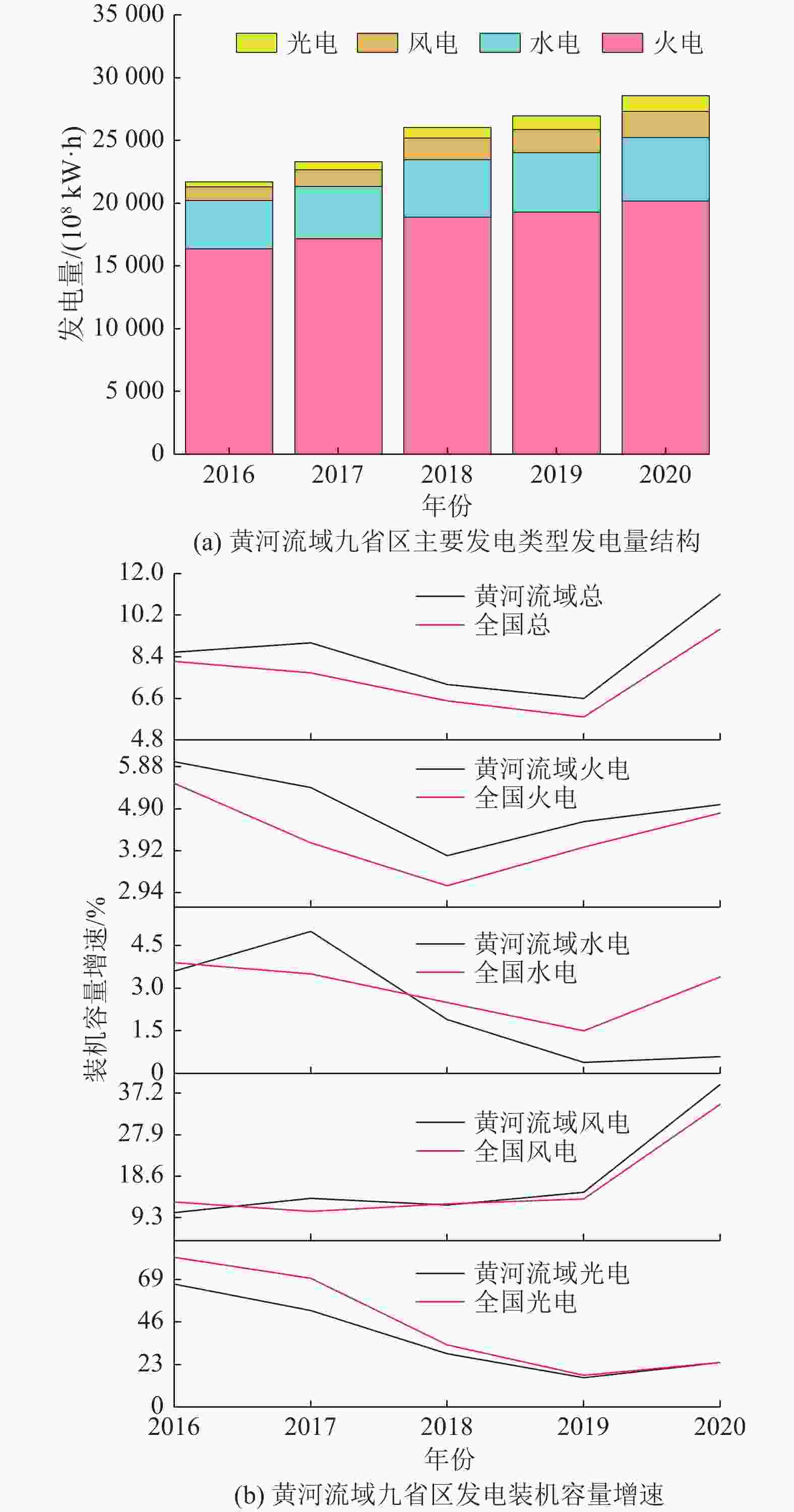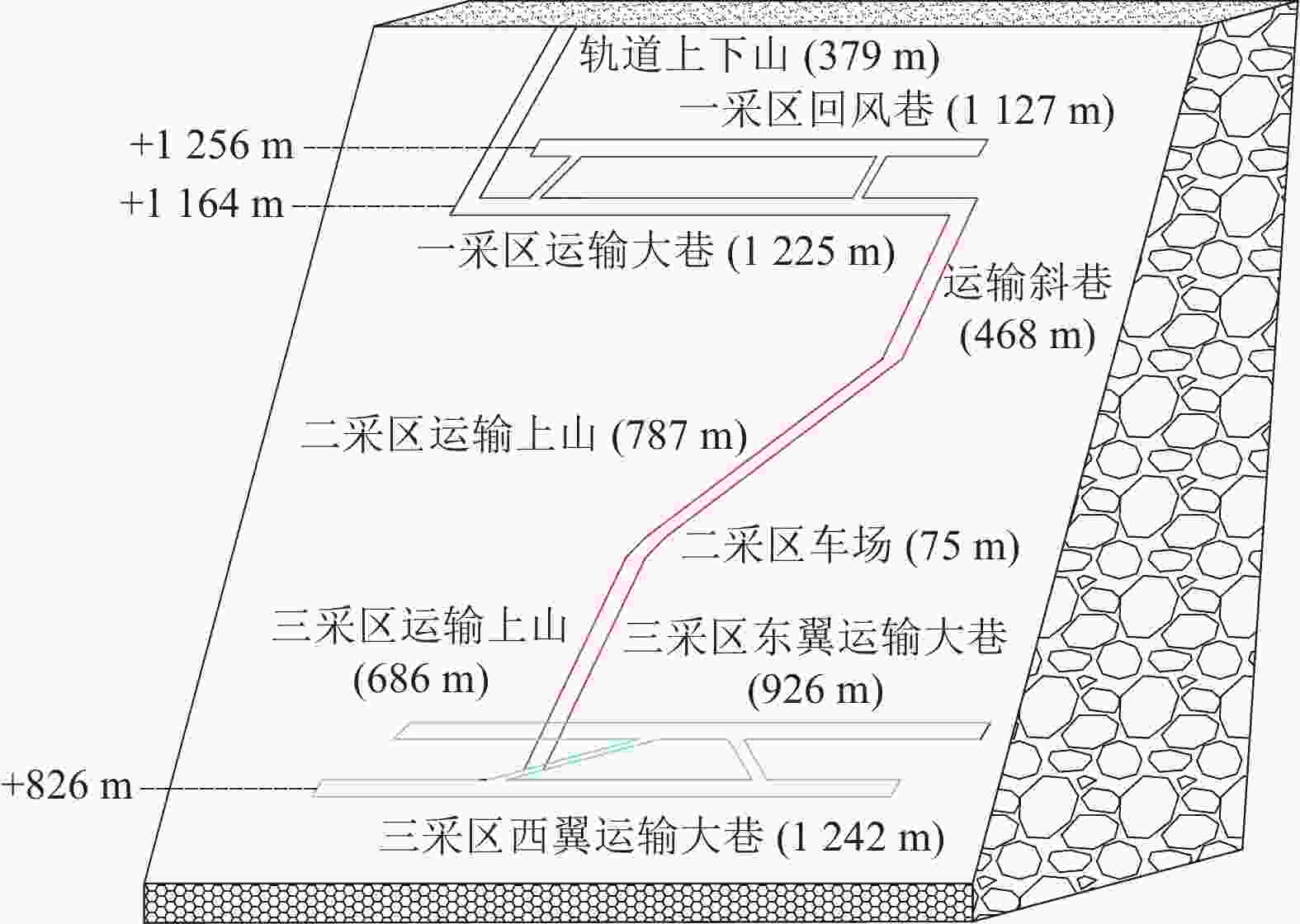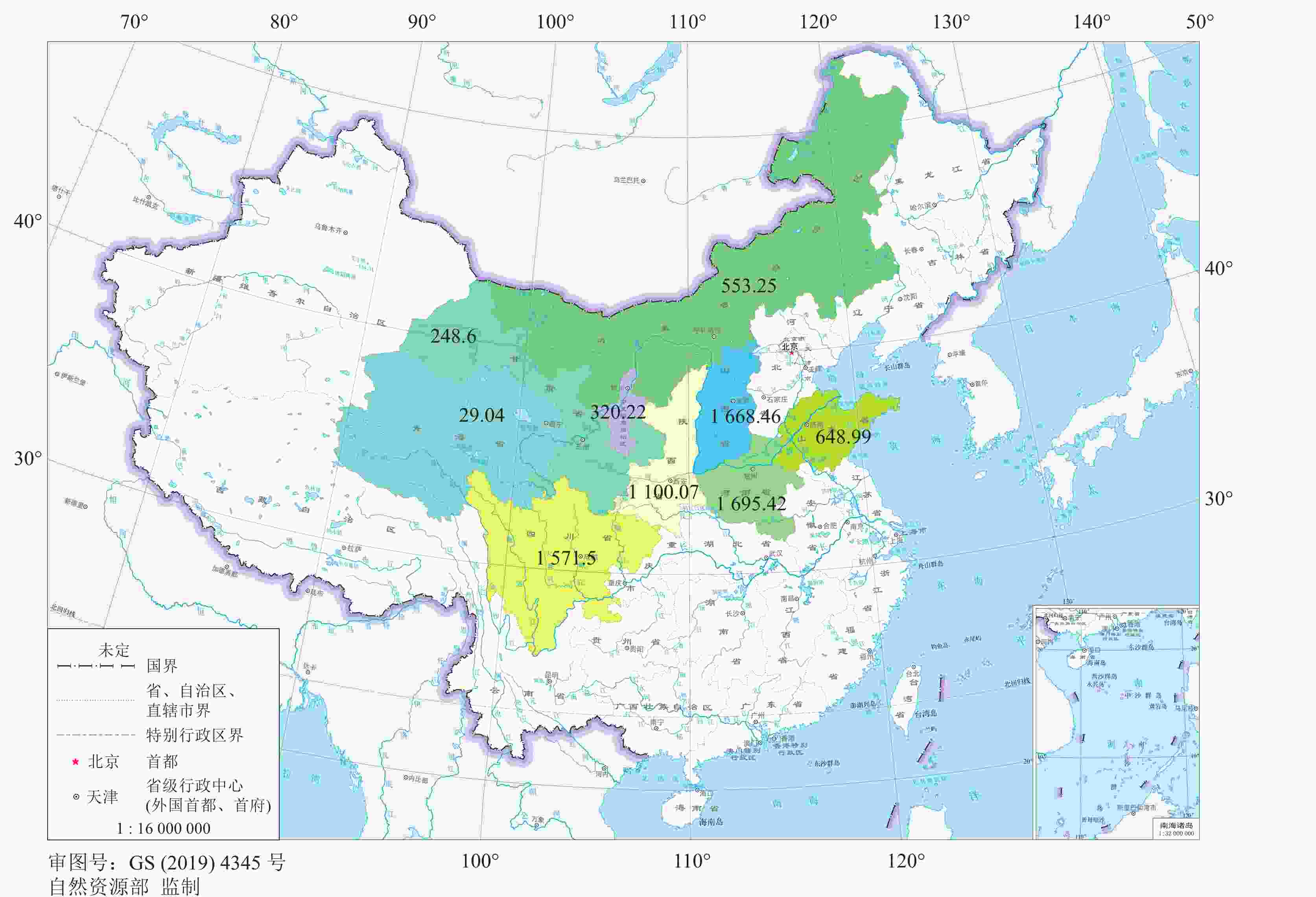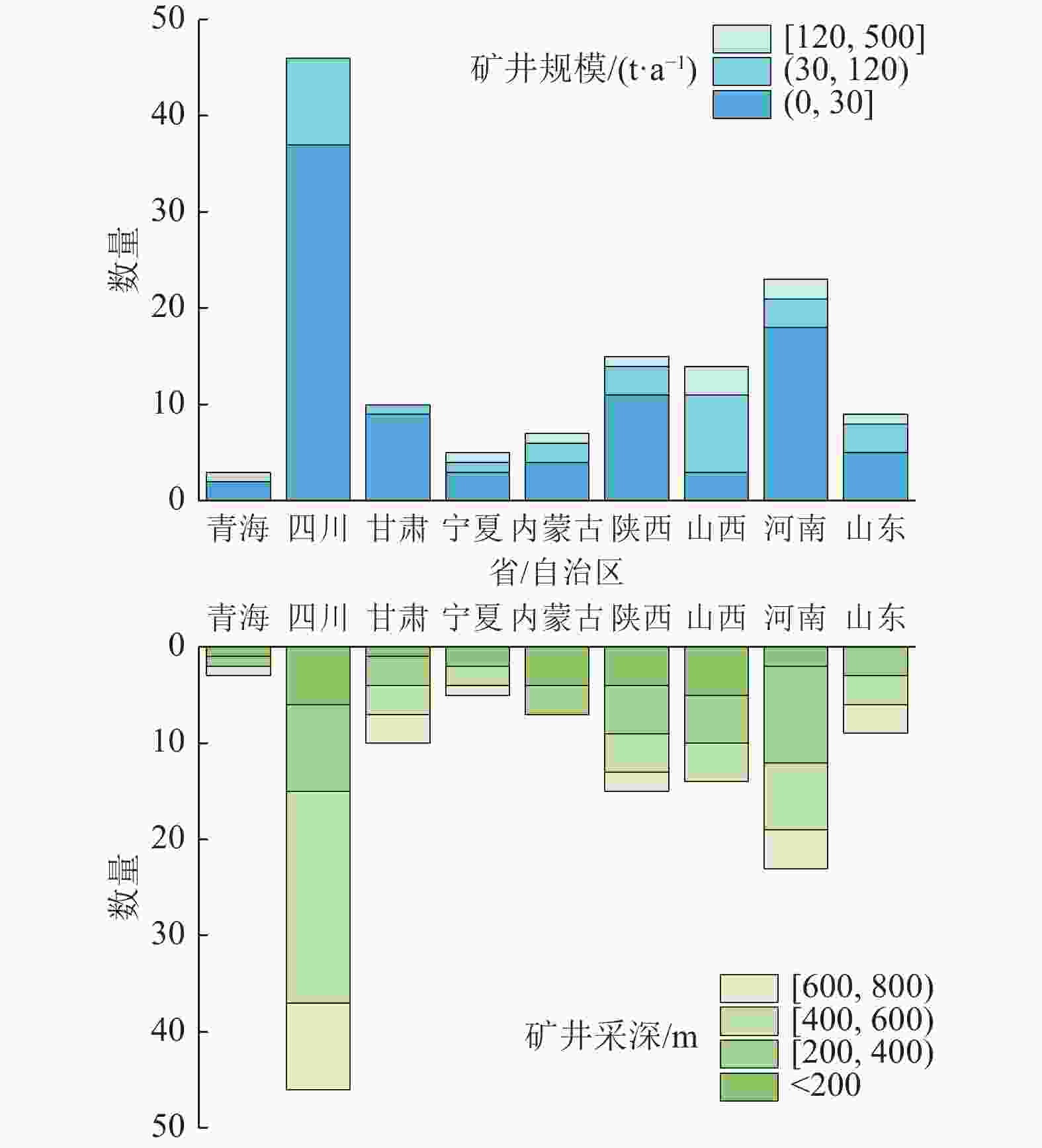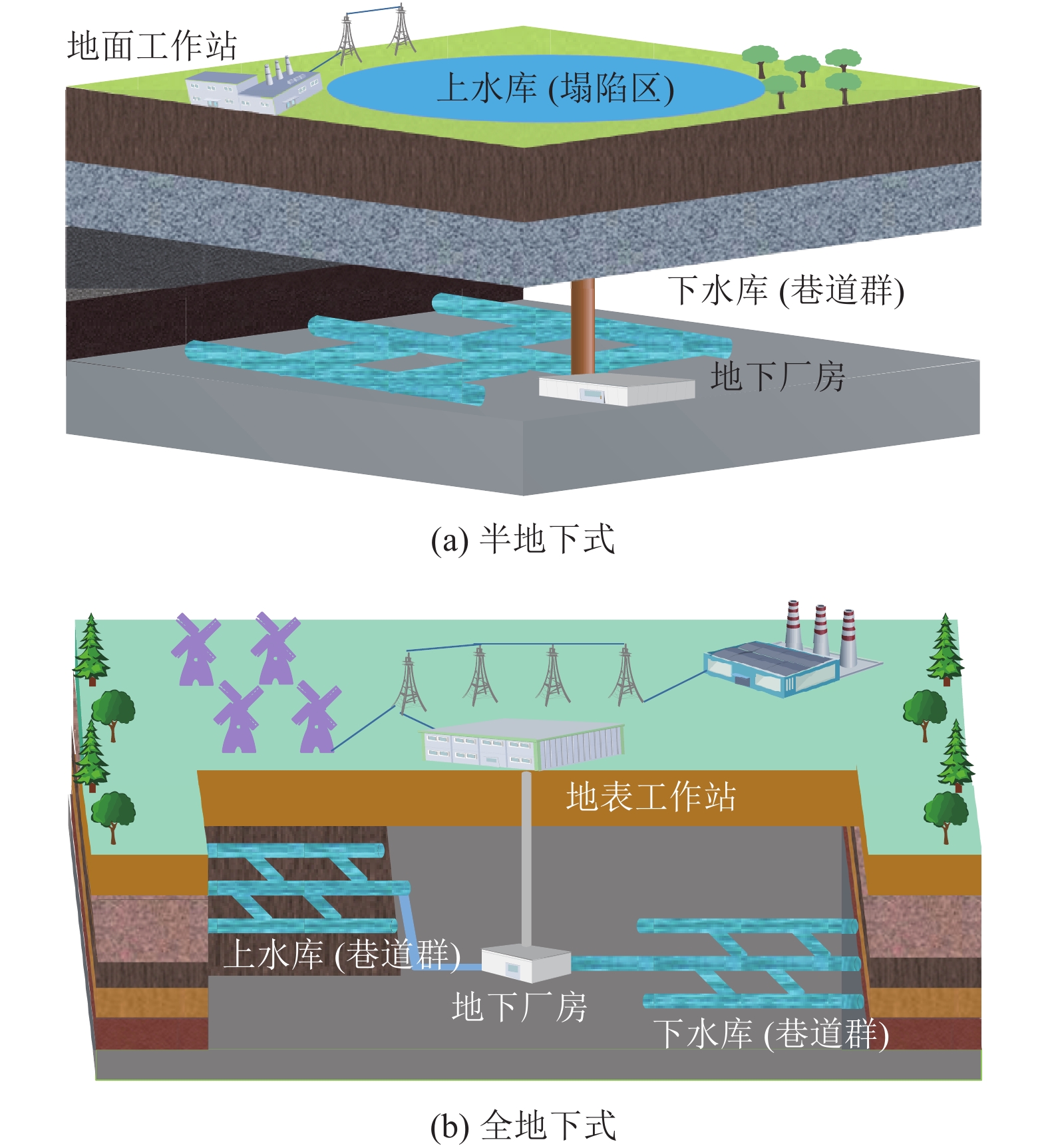Evaluation on potential of using abandoned mines for pumped storage in nine provinces of Yellow River Basin
-
摘要: 针对我国关闭矿井资源利用率低、蓄电储能需求日益增长的问题,废弃矿井抽水蓄能技术是实现资源二次开发利用,提升电网调峰能力的有效手段。基于废弃矿井抽水蓄能电站工作原理与发展现状,提出在黄河流域九省区利用废弃矿井建设抽水蓄能电站的半地下式、全地下式2种模式。通过综合考虑空间、地质、水文、社会、经济与资源等影响因素,提出废弃矿井抽水蓄能电站选址评价指标体系,并进行黄河流域废弃矿井抽水蓄能电站实例分析。基于2016—2020年黄河流域九省区的废弃煤矿资料,利用废弃矿井抽水蓄能电站静态效益与动态效益计算方法,定量评估黄河流域九省区废弃煤矿抽水蓄能电站建设的开发潜力。结果表明:(1) 黄河流域九省区能源资源丰富,现阶段满足电力供应需求,但火电仍是电力供应主体且水电发展进入瓶颈阶段;(2) 影响废弃矿井抽水蓄能电站选址的重要因素为巷道空间体积、上下水库水位差、巷道围岩稳定性、巷道围岩渗透率与地下水循环特征;(3) 由黄河流域废弃矿井抽水蓄能电站实例分析可知,其发电效率可达到75.7%,可媲美常规抽水蓄能电站;(4) 2016—2020年黄河流域九省区废弃煤矿累计有效可利用井巷空间为4.7×107 m3,依据132座废弃矿井基本情况,从统计学角度估算出废弃矿井抽水蓄能电站可利用井巷空间为1.34×107 m3,利用其建设抽水蓄能电站年发电量可达3.78×109 kW·h,可满足2021年黄河流域九省区28.4%的弃风、弃光电量的消纳需求,每年直接经济效益约达21.2亿元。综上表明,黄河流域九省区废弃矿井抽水蓄能利用具有可观的发展前景。Abstract: In view of the low utilization rate of closed mine resources and the increasing demand for power and energy storage in China, the pumped storage technology of abandoned mine is an effective means to realize the secondary development and utilization of resources and enhance the peak sheaving capacity of power grid. Based on the working principle and development status of pumped storage power plants using the abandoned mines, it was proposed to build the semi-underground and full-underground pumped storage power plants using the abandoned mines in the nine provinces of Yellow River Basin. By considering the influence factors of space, geology, hydrology, society, economy and resources, an evaluation index system of site selection for pumped storage power plants using the abandoned mine was developed and an case analysis was performed for the pumped storage power plants using abandoned mine in Yellow River Basin. Besides, the development potential of pumped storage power plants using abandoned coal mines in the nine provinces of Yellow River Basin was quantitatively assessed based on the data of abandoned coal mines in the nine provinces of Yellow River Basin from 2016 to 2020 and the calculation methods of static and dynamic benefits of pumped storage power plants using the abandoned mines. The research shows that: (1) Rich energy resources are distributed in the nine provinces in Yellow River Basin and could meet the demand for electricity supply at present, but thermal power is still the main source of electricity supply while hydropower has entered the bottleneck stage of development. (2) The important influencing factors for the site selection of pumped storage power plant using abandoned mine are the special volume of drifts, the water level difference between the upper and lower reservoirs, the stability and permeability of the drift surrounding rocks and the characteristics of groundwater circulation. (3) According to the case analysis on the pumped storage power plant using abandoned mine in Yellow River Basin, it is found that its power generation efficiency could reach 75.7%, which is comparable to that of the conventional pumped storage power plant. (4) The cumulative special volume of shafts and drifts available in the abandoned coal mines in the nine provinces of Yellow River Basin from 2016 to 2020 is 4.7×107 m3. According to the basic information of 132 abandoned mines, it is further estimated from the statistical point of view that the available space of shafts and drifts for the pumped storage power plant in the abandoned mine is 1.34×107 m3, and it is calculated that the annual power generation of the pumped storage power plants using the abandoned mines would reach 3.78×109 kW·h, which could meet the consumption demand for 28.4% of the abandoned wind and photovoltaic power in the nine provinces of Yellow River Basin in 2021, with an annual direct economic benefit of about 2.12 billion yuan. To sum up, the utilization of abandoned mine for pumped storage power plant in the nine provinces of Yellow River Basin has huge prospects of development.
-
表 1 国外部分废弃矿井抽水蓄能电站工程设计参数[23]
Table 1 Engineering design parameters of some pumped storage power plants using abandoned mines abroad[23]
电站名称 类型 水库巷道长/m 水头/m 库容/103 m3 功率/MW 储能容量/(MW·h) 西班牙Asturian发电站 半地下 5 700 300~600 170 23.52 141 南非Fast West Rand发电站 全地下 67 000 1 200/1 500 1 000 抽955/发1 230 6 800 德国Prosper-Haniel发电站 半地下 15 500 560 600 200 820 德国Grund ore mine发电站 全地下 25 000 700 240~260 100 400 表 2 2020年黄河流域九省区主要能源矿产储量情况
Table 2 Main energy mineral reserves in the nine provinces of Yellow River Basin in 2020
省/自治区 煤炭/亿t 石油/万t 天然气/亿m3 青海 2.26 8 251.85 1 055.32 四川 26.66 555.40 15 274.98 甘肃 15.31 39 560.97 588.00 宁夏 35.01 4 670.51 280.67 内蒙古 194.47 6 676.91 10 123.53 陕西 293.90 36 812.83 11 096.45 山西 507.25 0 1 402.04 河南 33.65 3 022.24 62.82 山东 41.32 25 493.92 343.52 合计 1 149.83 125 044.63 40 227.33 全国 1 622.88 361 885.75 62 665.78 表 3 2016—2020年黄河流域九省区关闭煤矿情况
Table 3 Closed coal mines in the nine provinces of Yellow River Basin from 2016 to 2020
省/自治区 不同产能规模/(万t·a−1) 合计 (0,30] (30,120) [120,500] 数量 规模 数量 规模 数量 规模 数量 规模 青海 19 168 0 0 1 120 20 288 四川 447 4 925 11 840 1 150 459 5 915 甘肃 92 965 8 435 0 0 100 1 400 宁夏 31 581 13 823 3 617 47 2 011 内蒙古 41 1 230 22 1 225 5 660 68 3 085 陕西 116 2 457 32 1 890 7 1 250 155 5 597 山西 33 894 80 4 965 25 5 030 138 10 889 河南 208 3 841 29 1 561 5 900 242 6 302 山东 51 969 29 1 535 5 905 85 3 409 总计 1 038 16 030 224 13 274 52 9 632 1 314 38 896 注:数据统计来源,2016—2020年黄河流域九省区煤炭行业化解过剩产能关闭煤矿名单,关停煤矿不计入。 表 4 一致性检验结果
Table 4 Consistency test results
专家 一致性检验 判断矩阵 A-B B1-C B2-C B3-C B4-C B5-C B6-C 专家1 λmax 6.015 9 4.061 8 4.068 3 4.166 7 6.211 8 3.009 2 3.094 8 CR 0.002 5 0.023 1 0.023 9 0.062 5 0.033 6 0.008 9 0.091 1 专家2 λmax 6.093 9 4.089 0 4.045 8 4.191 6 6.273 6 3.018 3 3.005 5 CR 0.014 9 0.033 3 0.017 1 0.071 8 0.043 4 0.017 6 0.005 3 专家3 λmax 6.087 2 4.083 9 4.166 2 4.045 4 6.412 7 3.009 2 3.018 3 CR 0.013 8 0.031 4 0.062 2 0.017 0 0.065 5 0.008 9 0.017 6 专家4 λmax 6.059 2 4.051 9 4.109 1 4.159 3 6.577 9 3.044 4 3.053 9 CR 0.009 4 0.019 4 0.040 8 0.059 7 0.091 7 0.042 7 0.051 9 专家5 λmax 6.032 8 4.186 5 4.144 8 4.131 6 6.338 6 3.000 0 3.018 3 CR 0.005 2 0.069 8 0.054 2 0.049 3 0.053 7 0 0.017 6 表 5 废弃矿井抽水蓄能选址各指标权重
Table 5 Weights of each index for site selection of pumped storage plant using abandoned mines
准则层 权重 指标层 综合权重 排序 空间条件 B1 0.304 4 巷道空间体积C1 0.123 9 3 巷道地形条件C2 0.020 4 12 上下水库水位差C3 0.142 7 1 巷道瓦斯含量C4 0.017 4 15 地质条件 B2 0.299 2 巷道围岩稳定性C5 0.133 2 2 巷道围岩渗透率C6 0.123 3 4 地质灾害类别C7 0.013 9 18 地质灾害频率C8 0.028 7 9 水文条件 B3 0.151 6 水源水质C9 0.014 2 17 矿井涌水量C10 0.030 8 8 水库注水水源C11 0.015 5 16 地下水循环特征C12 0.091 1 5 社会条件 B4 0.073 7 当地用电需求量C13 0.022 2 11 矿区交通便捷度C14 0.005 5 22 与电网距离C15 0.008 3 21 与城市距离C16 0.008 8 20 当地政策支持度C17 0.023 9 10 就业率C18 0.005 0 23 经济条件 B5 0.129 1 单位储能成本C19 0.055 9 7 投资回收年限C20 0.012 8 19 工程收益率C21 0.060 5 6 资源条件 B6 0.042 0 当地有效风速C22 0.019 4 13 平均降水量C23 0.018 7 14 太阳辐射时间C24 0.004 0 24 表 6 废弃矿井抽水蓄能电站基本参数
Table 6 Basic parameters of pumped storage power plant using abandoned mine
参数 数值 上水库平均水位/m 1 210 上水库总容积/m3 34 600 下水库正常储水高度/m 4.5 下水库正常储水位高程/m 830.5 下水库总容积/m3 41 200 上下水库自然高程差/m 338 上下水库容积之比 0.84 输水巷道长度/m 2 016 表 7 黄河流域九省区部分废弃矿井抽水蓄能电站建设模式
Table 7 Construction mode of some pumped storage power plants using abandoned mines in nine provinces of Yellow River Basin
省/自治区 半地下式建设矿井数 全地下式建设矿井数 200~400 m 400~600 m 600~800 m 200~400 m 400~600 m 青海 1 0 0 0 1 四川 9 22 4 4 1 甘肃 3 3 2 0 1 宁夏 0 2 0 1 0 内蒙古 3 0 0 0 0 陕西 5 4 1 0 1 山西 5 4 0 0 0 河南 10 7 2 1 1 山东 3 3 2 0 1 表 8 2016—2020黄河流域九省区废弃矿井抽水蓄能电站可利用井巷资源量
Table 8 Available shaft and drift resources for pumped storage power plants in abandoned mines in nine provinces of Yellow River Basin in 2016-2020
单位:万m3 省/自治区 半地下式 全地下式 [200, 400) m [400, 600) m [600, 800) m [200, 400) m [400, 600) m 青海 1.74 0.00 0.00 0 1.7424 四川 72.12 176.46 32.08 32.08 8.02 甘肃 18.12 18.12 12.08 0 6.04 宁夏 0 20.75 0 10.36 0 内蒙古 27.44 0 0 0 0 陕西 72.60 58.08 14.52 0 14.52 山西 103.43 82.74 0 0 0 河南 181.72 127.20 36.34 18.17 18.17 山东 58.41 58.41 38.94 0 19.47 表 9 2021年黄河流域九省区峰谷电价差统计数据
Table 9 Statistical data of peak-to-valley electricity price difference in nine provinces of Yellow River Basin in 2021
地区 一般工商业峰谷价差/(元·kW−1·h−1) 大工业峰谷价差/(元·kW−1·h−1) <1 kV 1~10(20) kV ≥35 kV 1~10(20) kV 35 kV 110 kV 220 kV 青海 0.444 6 0.438 4 0.398 8 0.424 2 0.411 6 0.399 0 0.390 4 四川 0.615 2 0.602 2 0.589 2 0.540 2 0.520 2 0.498 2 0.475 2 甘肃 0.581 4 0.571 4 0.561 4 0.438 3 0.428 3 0.418 3 0.409 3 宁夏 0.407 6 0.391 6 0.375 6 0.318 8 0.294 8 0.278 8 0.262 8 内蒙古东部 0.717 1 0.680 0 0.594 3 0.492 1 0.485 1 0.445 7 0.422 7 内蒙古西部 0.217 9 0.217 9 0.217 9 0.217 9 0.217 9 0.217 9 0.217 9 陕西榆林 0.564 7 0.544 7 0.524 7 0.530 7 0.511 8 0.486 6 0.486 6 陕西其他 0.577 4 0.557 4 0.537 4 0.633 4 0.608 2 0.583 0 0.576 8 山西 0.455 1 0.435 8 0.421 3 0.438 7 0.409 8 0.385 6 0.366 3 河南 0.624 5 0.596 0 0.566 4 0.622 4 0.606 3 0.590 3 0.581 7 山东 0.744 5 0.728 1 0.711 6 0.735 7 0.717 7 0.699 7 0.681 7 -
[1] 习近平. 在第七十五届联合国大会一般性辩论上的讲话[R]. 北京: 中华人民共和国国务院, 2020. [2] IEA. Global CO2 emissions rebounded to their highest level in history in 2021[EB/OL]. (2022-03-08) [2022-06-03]. https://www.iea.org/news/global–CO2–emissions–rebounded–to–their–highest–level–in–history–in–2021. [3] 张智刚,康重庆. 碳中和目标下构建新型电力系统的挑战与展望[J]. 中国电机工程学报,2022,42(8):2806−2818.ZHANG Zhigang,KANG Chongqing. Challenges and prospects for constructing the new–type power system towards a Carbon Neutrality future[J]. Proceedings of the CSEE,2022,42(8):2806−2818. [4] 舒印彪,张丽英,张运洲,等. 我国电力碳达峰、碳中和路径研究[J]. 中国工程科学,2021,23(6):1−14.SHU Yinbiao,ZHANG Liying,ZHANG Yunzhou,et al. Carbon Peak and Carbon Neutrality path for China’s power industry[J]. Strategic Study of CAE,2021,23(6):1−14. [5] 黎博, 陈民铀, 钟海旺, 等. 高比例可再生能源新型电力系统长期规划综述[J/OL]. 中国电机工程学报, 2022: 1–27 [22-06-03]. https://doi.org/10.13334/j.0258–8013.pcsee.212716.LI Bo, CHEN Minyou, ZHONG Haiwang, et al. A review of long–term planning of new power systems with large share of renewable energy[J/OL]. Proceedings of the CSEE, 2022: 1–27 [2022-06-03]. https://doi.org/10.13334/j.0258–8013.pcsee.212716. [6] 郭志忠,叶瑞丽,刘瑞叶,等. 含抽水蓄能电站的可再生能源电网优化调度策略[J]. 电力自动化设备,2018,38(3):7−15.GUO Zhizhong,YE Ruili,LIU Ruiye,et al. Optimal scheduling strategy for renewable energy system with pumped storage station[J]. Electric Power Automation Equipment,2018,38(3):7−15. [7] 刘钦节,王金江,杨科,等. 关闭/废弃矿井地下空间资源精准开发利用模式研究[J]. 煤田地质与勘探,2021,49(4):71−78.. doi: 10.3969/j.issn.1001-1986.2021.04.009LIU Qinjie,WANG Jinjiang,YANG Ke,et al. Research on the model of accurate exploitation and utilization of underground space resources in closed/abandoned mines[J]. Coal Geology & Exploration,2021,49(4):71−78.. doi: 10.3969/j.issn.1001-1986.2021.04.009 [8] 卞正富,周跃进,曾春林,等. 废弃矿井抽水蓄能地下水库构建的基础问题探索[J]. 煤炭学报,2021,46(10):3308−3318.BIAN Zhengfu,ZHOU Yuejin,ZENG Chunlin,et al. Discussion of the basic problems for the construction of underground pumped storage reservoir in abandoned coal mines[J]. Journal of China Coal Society,2021,46(10):3308−3318. [9] 朱超斌,周跃进,卞正富,等. 废弃矿井抽水蓄能句法视角下拓扑模型构建及空间优化[J]. 煤炭学报,2022,47(6):2279−2288.ZHU Chaobin,ZHOU Yuejin,BIAN Zhengfu,et al. Topological model construction and space optimization of abandoned mine pumped storage from the perspective of space syntax[J]. Journal of China Coal Society,2022,47(6):2279−2288. [10] 罗魁,石文辉,曹飞,等. 利用废弃矿洞建设抽水蓄能电站初探[J]. 中国能源,2018,40(10):42−47.. doi: 10.3969/j.issn.1003-2355.2018.10.007LUO Kui,SHI Wenhui,CAO Fei,et al. Preliminary study on construction of pumped storage power station by using abandoned mines[J]. Energy of China,2018,40(10):42−47.. doi: 10.3969/j.issn.1003-2355.2018.10.007 [11] 刘峰,李树志. 我国转型煤矿井下空间资源开发利用新方向探讨[J]. 煤炭学报,2017,42(9):2205−2213.LIU Feng,LI Shuzhi. Discussion on the new development and utilization of underground space resources of transitional coal mines[J]. Journal of China Coal Society,2017,42(9):2205−2213. [12] FESSENDEN R A. System of storing power: US1247520[P]. 1917-11-20. [13] WILLETT D C. Underground pumped storage research priorities: Technical planning study[M]. Palo Alto: Electric Power Research Institute, 1976. [14] TAM S W, BLOMQUIOT C A, KARTSOUNES G T. Underground pumped hydro storage: An overview[R]. Chicago: Harza Engineering Company, 1977. [15] CHARLES T. Underground hydroelectric pumped storage: An evaluation of the concept[M]. Boston: Main, 1978. [16] HARZA R D. Hydro and pumped storage for peaking[J]. Power Engineering,1960,64(10):79−82. [17] CHIU H H,RODGERS L W,SALEEM Z A,et al. Mechanical energy storage systems:Compressed air and underground pumped hydro[J]. Journal of Energy,1979,3(3):131−139.. doi: 10.2514/3.62426 [18] SEIWALD S. Erweiterung Kraftwerk Naßfeld–Erhöhung Bockhartseedamm[J]. Ö sterreichische Wasser−und Abfallwirtschaft,2007,59(7):91−97. [19] NIEMANN A,BALMES J P,SCHREIBER U,et al. Proposed underground pumped hydro storage power plant at Prosper−Haniel Colliery in Bottrop−State of play and prospects[J]. Mining Report Glückauf,2018,154(3):214−223. [20] WINDE F,KAISER F,ERASMUS E. Exploring the use of deep level gold mines in South Africa for underground pumped hydroelectric energy storage schemes[J]. Renewable and Sustainable Energy Reviews,2017,78:668−682.. doi: 10.1016/j.rser.2017.04.116 [21] MONTERO R A, WORTBERG T, BINIAS J, et al. Integrated assessment of underground pumped–storage facilities using existing coal mine infrastructure[C]. London: Taylor & Francis Group, 2016. [22] WESSEL M,MADLENER R,HILGERS C. Economic feasibility of semi−underground pumped storage hydropower plants in open–pit mines[J]. Energies,2020,13(16):4178.. doi: 10.3390/en13164178 [23] 许雨喆. 基于废弃矿井的抽水蓄能电站设计[D]. 淮南: 安徽理工大学, 2019.XU Yuzhe. Design of pumped storage power station based on abandoned mines[D]. Huainan: Anhui University of Science and Technology, 2019. [24] 顾大钊. 煤矿地下水库理论框架和技术体系[J]. 煤炭学报,2015,40(2):239−246.GU Dazhao. Theory framework and technological system of coal mine underground reservoir[J]. Journal of China Coal Society,2015,40(2):239−246. [25] 谢和平,侯正猛,高峰,等. 煤矿井下抽水蓄能发电新技术:原理、现状及展望[J]. 煤炭学报,2015,40(5):965−972.XIE Heping,HOU Zhengmeng,GAO Feng,et al. A new technology of pumped–storage power in underground coal mine:Principles,present situation and future[J]. Journal of China Coal Society,2015,40(5):965−972. [26] 顾大钊. 能源“金三角”煤炭现代开采水资源及地表生态保护技术[J]. 中国工程科学,2013,15(4):102−107.. doi: 10.3969/j.issn.1009-1742.2013.04.018GU Dazhao. Water resource and surface ecology protection technology of modern coal mining in China’s energy“Golden Triangle”[J]. Strategic Study of CAE,2013,15(4):102−107.. doi: 10.3969/j.issn.1009-1742.2013.04.018 [27] 浦海,许军策,卞正富,等. 关闭/废弃矿井地热能开发利用研究现状与进展[J]. 煤炭学报,2022,47(6):2243−2269.PU Hai,XU Junce,BIAN Zhengfu,et al. Research status and progress of geothermal energy development and utilization from closed/abandoned coal mines[J]. Journal of China Coal Society,2022,47(6):2243−2269. [28] LIU Qin,SUN Yajun,XU Zhimin,et al. Assessment of abandoned coal mines as urban reservoirs[J]. Mine Water and the Environment,2019,38(2):215−225.. doi: 10.1007/s10230-019-00588-3 [29] MENENDEZ J,SCHMIDT F,KONIETZKY H,et al. Stability analysis of the underground infrastructure for pumped storage hydropower plants in closed coal mines[J]. Tunnelling and Underground Space Technology,2019,94:103117.. doi: 10.1016/j.tust.2019.103117 [30] MENENDEZ J,FERNANDEZ–ORO J M,GALDO M,et al. Pumped–storage hydropower plants with underground reservoir:Influence of air pressure on the efficiency of the Francis turbine and energy production[J]. Renewable Energy,2019,143:1427−1438.. doi: 10.1016/j.renene.2019.05.099 [31] KITSIKOUDIS V,ARCHAMBEAU P,DEWALS B,et al. Underground pumped–storage hydropower (UPSH) at the Martelange Mine (Belgium):Underground reservoir hydraulics[J]. Energies,2020,13(14):3512.. doi: 10.3390/en13143512 [32] PUJADES E,ORBAN P,ARCHAMBEAU P,et al. Underground pumped–storage hydropower (UPSH) at the Martelange Mine (Belgium):Interactions with groundwater flow[J]. Energies,2020,13(9):2353.. doi: 10.3390/en13092353 [33] FAN Jinyang,XIE Heping,CHEN Jie,et al. Preliminary feasibility analysis of a hybrid pumped–hydro energy storage system using abandoned coal mine goafs[J]. Applied Energy,2020,258:114007.. doi: 10.1016/j.apenergy.2019.114007 [34] PUJADES E,POULAIN A,ORBAN P,et al. The impact of hydrogeological features on the performance of Underground Pumped–Storage Hydropower (UPSH)[J]. Applied Sciences,2021,11(4):1760.. doi: 10.3390/app11041760 [35] 王兵,刘朋帅,邓凯磊. 基于模糊多准则决策模型的废弃矿井抽水蓄能电站选址研究[J]. 矿业科学学报,2021,6(6):667−677.WANG Bing,LIU Pengshuai,DENG Kailei. Site selection of pumped storage power station in abandoned mines:Results from fuzzy–based multi criteria decision model[J]. Journal of Mining Science and Technology,2021,6(6):667−677. [36] YONG Xingkai,CHEN Wenjun,WU Yunna,et al. A two–stage framework for site selection of underground pumped storage power stations using abandoned coal mines based on multi–criteria decision–making method:An empirical study in China[J]. Energy Conversion and Management,2022,260:115608.. doi: 10.1016/j.enconman.2022.115608 [37] XUE Jingguo,HOU Xueliang,ZHOU Jianli,et al. Obstacle identification for the development of pumped hydro storage using abandoned mines:A novel multi–stage analysis framework[J]. Journal of Energy Storage,2022,48:104022.. doi: 10.1016/j.est.2022.104022 [38] 杨立滨,冯冀,乔梁,等. 基于层次分析法与劳瑞模型的光伏电站综合效益评估[J]. 电力系统及其自动化学报,2018,30(11):120−125.. doi: 10.3969/j.issn.1003-8930.2018.11.020YANG Libin,FENG Ji,QIAO Liang,et al. Comprehensive benefit evaluation of PV power station based on AHP and Lowry Model[J]. Proceedings of the CSU−EPSA,2018,30(11):120−125.. doi: 10.3969/j.issn.1003-8930.2018.11.020 [39] 商大成. 毕节地区利用废弃煤矿地下空间建设抽水蓄能电站的研究[D]. 贵阳: 贵州大学, 2021.SHANG Dacheng. Study on construction of pumped storage power station by using underground space of waste coal mine in Bijie area[D]. Guiyang: Guizhou University, 2021. [40] 卢开放,侯正猛,孙伟,等. 云南省矿井抽水蓄能电站潜力评估与建设关键技术[J]. 工程科学与技术,2022,54(1):136−144.LU Kaifang,HOU Zhengmeng,SUN Wei,et al. Potential evaluation and construction key technologies of pumped−storage power stations in mines of Yunnan Province[J]. Advanced Engineering Sciences,2022,54(1):136−144. [41] 夏连宁. 关于输水管道水力计算公式选用的探讨[J]. 给水排水,2020,46(4):139−143.. doi: 10.13789/j.cnki.wwe1964.2020.04.024XIA Lianning. Discussion on section of water head loss calculation formulas[J]. Water & Wastewater Engineering,2020,46(4):139−143.. doi: 10.13789/j.cnki.wwe1964.2020.04.024 [42] 韩杨,张小珩,汪胜和,等. 废弃矿井抽水蓄能多场景利用可行性及技术经济研究[J]. 现代商贸工业,2020,41(11):210−213.HAN Yang,ZHANG Xiaoheng,WANG Shenghe,et al. Feasibility and technical and economic research on multi– scenario utilization of pumped storage in waste mine[J]. Modern Business Trade Industry,2020,41(11):210−213. [43] 王昊婧. 新形势下我国抽水蓄能电站运营效益评价方法研究[D]. 北京: 华北电力大学, 2016.WANG Haojing. Pumped–storage power station operation efficiency evaluation method[D]. Beijing: North China Electric Power University, 2016. [44] 曹飞, 王婷婷, 唐修波. 利用废弃矿井建设抽水蓄能电站的效益探讨[C]//抽水蓄能电站工程建设文集(2020). 北京: 中国水利水电出版社, 2020. [45] 高瑾瑾,郑源,李涧鸣. 基于改进序关系分析法的抽水蓄能电站经济效益综合评价[J]. 长江科学院院报,2018,35(4):137−142.. doi: 10.11988/ckyyb.20161372GAO Jinjin,ZHENG Yuan,LI Jianming. Comprehensive evaluation of economic benefits of pumped storage power plants by improved order relation analysis method[J]. Journal of Yangtze River Scientific Research Institute,2018,35(4):137−142.. doi: 10.11988/ckyyb.20161372 [46] 郗富瑞,张进德,王延宇,等. 中国废弃矿山地下抽水蓄能电站技术要点与可行性分析[J]. 科技导报,2020,38(11):41−50.. doi: 10.3981/j.issn.1000-7857.2020.11.005XI Furui,ZHANG Jinde,WANG Yanyu,et al. Technical key points and feasibility analysis of underground pumped storage power station in built abandoned mines in China[J]. Science & Technology Review,2020,38(11):41−50.. doi: 10.3981/j.issn.1000-7857.2020.11.005 [47] 谢和平,高明忠,刘见中,等. 煤矿地下空间容量估算及开发利用研究[J]. 煤炭学报,2018,43(6):1487−1503.XIE Heping,GAO Mingzhong,LIU Jianzhong,et al. Research on exploitation and volume estimation of underground space in coal mines[J]. Journal of China Coal Society,2018,43(6):1487−1503. [48] SHANG Dacheng,PEI Peng. Analysis of influencing factors of modification potential of abandoned coal mine into pumped storage power station[J]. Journal of Energy Resources Technology,2021,143(11):112003.. doi: 10.1115/1.4049608 [49] 张保生,陈宁,高博,等. 废弃矿井抽水蓄能电站水泵水轮机关键技术[J]. 科技导报,2021,39(13):66−72.. doi: 10.3981/j.issn.1000-7857.2021.13.008ZHANG Baosheng,CHEN Ning,GAO Bo,et al. Key technologies of pump–turbine in underground pumped storage station using abandoned mine[J]. Science & Technology Review,2021,39(13):66−72.. doi: 10.3981/j.issn.1000-7857.2021.13.008 -








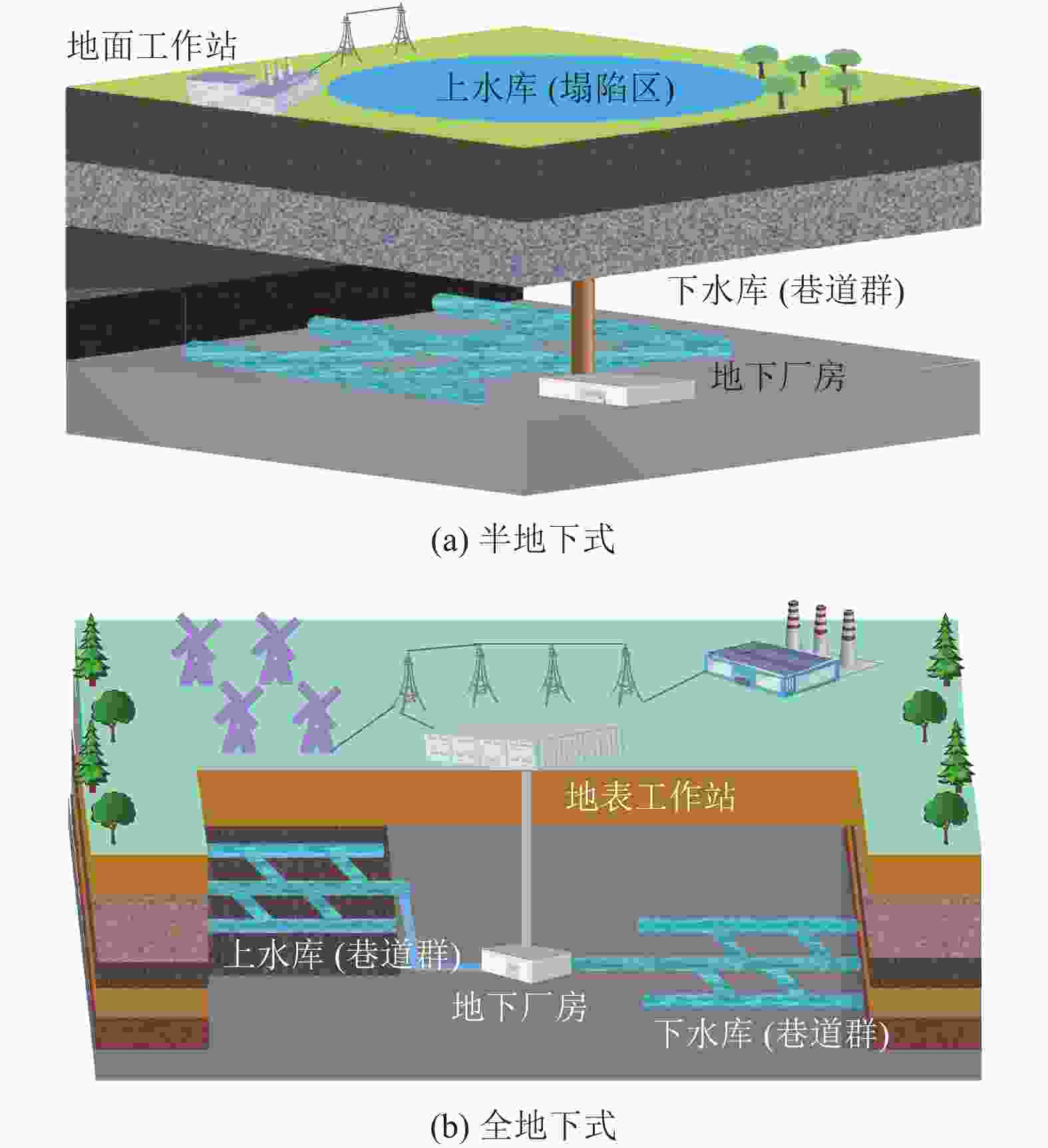
 下载:
下载:
